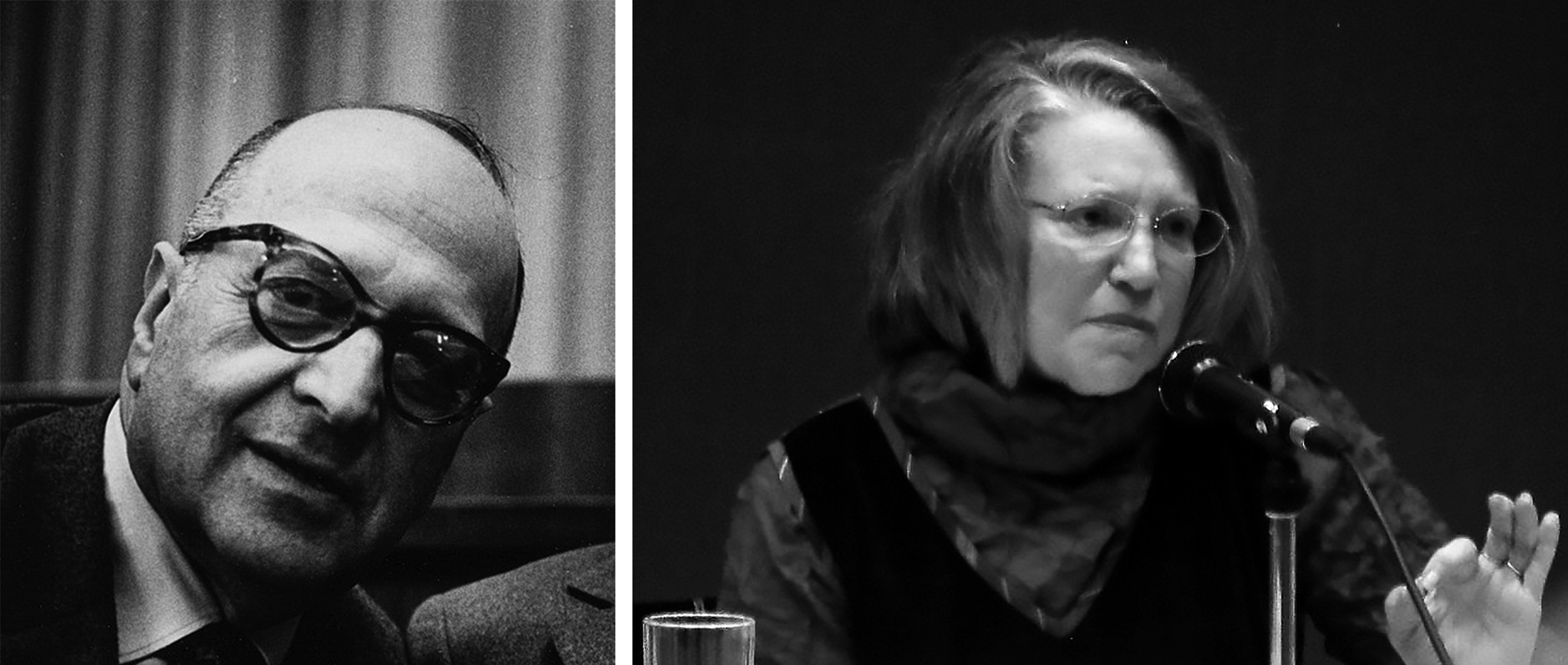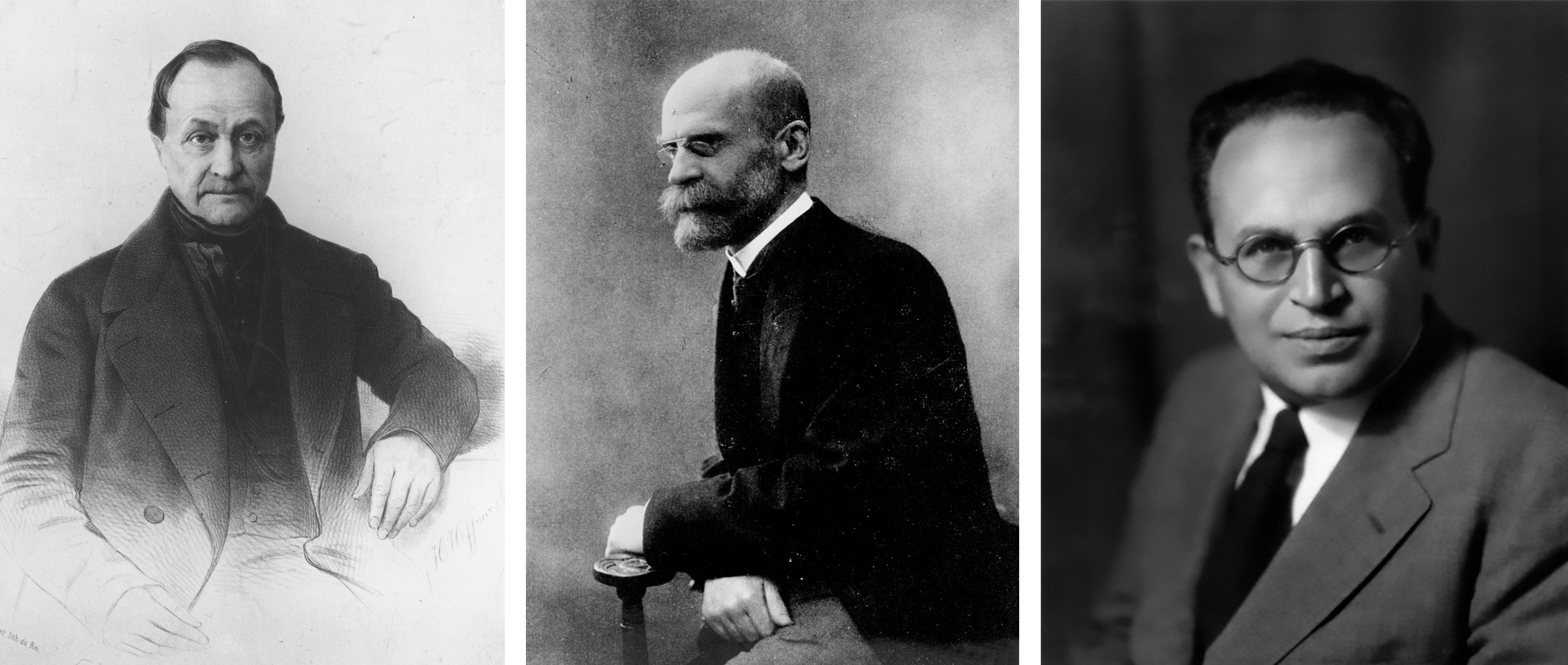3. The Role of Theory in Research
3.5. Major Sociological Theories and Paradigms
Learning Objective
Identify and describe the dominant theoretical perspectives and paradigms in the social sciences.
Social theories provide a way of looking at the world and understanding human interaction. In the previous sections, we noted that theories are not just collections of facts; they need to put forward some sort of explanatory story. At the same time, theories operate at many different levels, not just in terms of their units of analysis, but also in how grand or sweeping—or restricted or specific—an explanation they provide.
Most theories (especially the ones that you, as a novice researcher, would tackle for your first study) are narrow in focus. They might aim to provide a compelling explanation for one particular phenomenon, in one specific context. Moving up the ladder of ambition and complexity, however, we arrive at cohesive collections of theories—what we might think of as “major” or “overarching” theories, or theoretical traditions or theoretical perspectives—that aim to explain the very existence and persistence of society as we know it. Introductory sociology courses typically teach students about the “big three” sociological theories: structural functionalism, conflict theory, and symbolic interactionism. As you might recall, structural functionalism focuses on the interrelations between various parts of society and how each part works with the others to make society function in the way that it does—much like parts of the body work together to help an organism to thrive. Conflict theory is interested in questions of power. Scholars in this tradition examine who wins and who loses based on the way that society is organized. Symbolic interactionism studies how meaning is created and negotiated through social interactions. Sociologists who use this approach focus on symbols, the ways that people communicate their thoughts and feelings.
Just as researchers can examine the same topic from different levels of inquiry, so, too, can they investigate the same topic from different theoretical perspectives. In this case, even their research questions could be the same, but the way they make sense of whatever phenomenon it is they are investigating will be shaped in large part by their choice of a theoretical perspective and the assumptions that underlie it.
Table 3.1 summarizes the major points of focus for each of the three major theories and outlines how a researcher might approach the study of the same topic—in this case, the study of sports—from each of the three perspectives.
Table 3.1. Major Sociological Theories and the Study of Sports
|
Theoretical perspective |
Focuses on |
A study of sports might examine … |
|
Structural functionalism |
Interrelations between parts of society, and how those parts work in concert |
The consequences—positive and negative, intended and unintended—of professional sport leagues |
|
Conflict theory |
Who wins and who loses based on the way that society is organized |
Issues of power in sports, such as differences in participation and access to training |
|
Symbolic interactionism |
How meaning is created and negotiated through interactions |
How the rules of sports are constructed, taught, and learned |

Within each area of specialization in sociology, there are many other theories that aim to explain more specific types of interactions. For example, within the sociological study of sexual harassment, different theories suggest different explanations for why harassment occurs. One theory, first developed by criminologists, is called routine activities theory. It argues that sexual harassment is most likely to occur when a workplace lacks unified groups, and when potentially vulnerable targets and motivated offenders are both present (De Coster, Estes, and Mueller 1999). Other theories of sexual harassment, called relational theories, suggest that a person’s relationships, such as their marriages or friendships, are the key to understanding why and how workplace sexual harassment occurs, and how people will respond to it when it does occur (Morgan 1999). Relational theories focus on the power that different social relationships provide. For example, married people who have supportive partners at home might be more likely than those who lack support at home to report sexual harassment when it occurs. Finally, feminist theories of sexual harassment argue that the way our current gender system is organized—giving the most power to those who are the most masculine—best explains why and how workplace sexual harassment occurs (MacKinnon 1979).
As is true for the study of any topic, which theory you apply to examine sexual harassment will shape which research questions you ask. It will also influence the sorts of explanations you provide for why harassment occurs. Given how complex our social realities are, all of these theories may be true at the same time, though some may work better in certain contexts. Research can help us weigh the impact of these different factors.
Paradigms vs. Theories: Why and How
Paradigms stand at an even higher level of abstraction than the theoretical perspectives we were just talking about. The terms “paradigm” and “theory” are often used interchangeably in social science, but here we follow other researchers in distinguishing between the two ideas, which can help us to understand the connections between research methods and social scientific ways of thinking. More encompassing than mere theories, paradigms are ways of viewing the world and understanding the human experience. They frame what we know, what we can know, and how we can know it.

The term “paradigm” was popularized by the philosopher Thomas Kuhn. In his book The Structure of Scientific Revolutions (1962), Kuhn examined the history of the natural sciences to identify patterns of activities that determine the progress of science. As mental models or frames of references, paradigms organize our reasoning and observations, Kuhn argued. As belief systems, they contain underlying, and often unacknowledged, assumptions. In these ways, paradigms fundamentally shape the ways that scientists design and conduct research. At any given moment, a field of science may be dominated by a particular paradigm; as more research accumulates that challenges that paradigm, however, the field may undergo what Kuhn called a paradigm shift, during which the field’s scientists gradually adopt a new way of understanding reality that better fits the available evidence. (Most famously, this paradigm shift occurred when Isaac Newton’s classical theories of physics were replaced by Albert Einstein’s theories of relativity.)

Each individual’s viewpoint is shaped by many paradigms—from moral and political ones, to social scientific ones. These paradigms are like “colored glasses” that govern how we view the world and how we think about what we see in the world. Like colored glasses, we become used to them over time and may forget they’re even there. Indeed, it can be difficult to fully grasp the idea that our way of looking at the world reflects a particular paradigm and set of accompanying assumptions. As individuals, we are very much steeped in our own personal and everyday perspective. For example, consider people’s views on abortion. To some, abortion is a medical procedure that should be undertaken at the discretion of each individual who might experience an unwanted pregnancy. To others, abortion is murder, and members of society should collectively have the right to decide when, if at all, abortion should be undertaken. If you have an opinion about this controversial topic, you might be pretty certain that you are “right.” The person who sits next to you in class may have a very different opinion and yet be equally confident about the truth of their perspective.
Which of you is correct? You are each operating under a set of assumptions about the way the world does—or at least should—work. Perhaps your assumptions come from your particular political perspective, which guides your view on a variety of social issues, or perhaps your assumptions are based on what you learned from your parents or the community (religious or otherwise) you were raised in. In any case, there is a paradigm that shapes your understanding of the issue and therefore your stance on it.
You can think of theories as nested within larger paradigms, providing different sorts of answers to our questions. As we noted earlier, theories help us answer the why questions we often have about the patterns we observe in social life. But even before we arrive at that theory, the paradigm we are operating under may point us in a particular direction with respect to our why questions. For better or worse, it may constrain our thinking and reasoning about what we observe. For instance, people may have very different opinions on how to solve social problems depending on what they believe the proper role of government should be in people’s lives. On the political right, conservatives and libertarians may believe that lowering taxes is the best way to stimulate a stagnant economy because it increases people’s disposable income and spending, which in turn expands business output and employment. On the political left, liberals and progressives may believe that governments should invest more directly in job creation programs such as public works and infrastructure projects, which will increase employment and people’s ability to consume, spurring greater economic output. Likewise, Western societies tend to emphasize individual rights, such as people’s right to privacy, right of free speech, and right to bear arms. In contrast, Asian societies often choose to balance the rights of individuals against the rights of families, organizations, and the government in ways that favor more communal and less individualistic policies. Such differences in perspective often lead Westerners to criticize Asian governments for being autocratic, while Asians criticize Western societies for being greedy and selfish. You might imagine how researchers from each of these backgrounds might take very different approaches to studying the same social policies or social norms—or how they might find entirely different topics worth studying in the first place.
As we’ve noted, paradigms are often hard to recognize because they are implicit and taken for granted. But identifying which paradigm a particular person is operating under is key to making sense of and reconciling differences in people’ perceptions of the same social phenomenon. For instance, if you ask the public what is the best way to improve the public education system, liberals and progressives might prefer paying teachers higher salaries, while conservatives and libertarians might prefer expanding the use of school vouchers—allowing parents to use tax dollars to send their children to private schools. What accounts for these differences in policy preferences are distinct assumptions that people on the left and right bring to their analysis of the educational system. On the right, people tend to place more faith in competitive markets: under a voucher system, the logic goes, schools will compete for education dollars, and that competition will create pressures for quality improvements. On the left, people prioritize treating workers well, with the idea that higher wages will create incentives for better teaching.
Paradigms in Social Science
Let’s look at four of the most common social scientific paradigms that might guide you as you begin to think about conducting research (Table 3.2 summarizes each of them). Consciously or unconsciously, these paradigms constrain the concepts that researchers attempt to measure, their observations of a particular phenomenon, and their subsequent interpretations of that phenomenon.
The first paradigm we’ll consider, called positivism, is probably the framework that comes to mind for many of you when you think of science. Positivism is guided by the principles of objectivity, knowability, and deductive logic. (Deductive logic is discussed in more detail in Chapter 4: Research Questions.) The positivist framework operates from the assumption that society can and should be studied empirically and scientifically. It holds that science or knowledge creation should be restricted to what can be observed and measured.
The French philosopher Auguste Comte, the person who coined the term sociology, argued that the discipline should be a positivist science (Ritzer and Stepnisky 2017). Blending together notions of rationalism and empiricism, Comte suggested that theory and observations have a circular dependence on each other—that is, they build upon each other in ways similar to the feedback loops we mentioned earlier. Specifically, while theories may be created via reasoning, they are only authentic if they can be verified through observations, Comte argued. This emphasis on verification pushed the social scientists of the day to separate themselves from the purely theoretical fields of philosophy and metaphysics and embrace the “scientific method” as the primary means of validating scientific claims.
The French philosopher Auguste Comte (1798–1857) promoted the new field of “sociology”—a term he invented—as a reason-based science that would only hold truths to be evident when they were backed up by empirical observations. The sociologists Émile Durkheim (1858–1917) and Paul Lazarsfeld (1901–1976) followed in this tradition, which eventually led to the field being dominated by quantitative researchers who drew upon national survey data and the new science of probability sampling (described in Chapter 6: Sampling). Johan Hendrik Hoffmeister / Wikimedia Commons / Bardwell Press
Key scholars who built on Comte’s ideas about positivism included Émile Durkheim, who developed sociological positivism (positivism as a foundation for social research) and Ludwig Wittgenstein, who developed logical positivism (positivism as a foundation for philosophy). In the field of sociology, positivism in sociology often took the form of large-scale survey research. For example, the American sociologist Paul Lazarsfeld pioneered the creation of national surveys, along with new statistical techniques to analyze the quantitative data that these surveys produced.
As we noted, positivism relies on theories that can be directly tested. It was originally an attempt to separate scientific inquiry from religion, whose beliefs could not be objectively tested. But critics charged it went too far in the opposite direction, leading to a blind faith in data and a rejection of any attempts to reason beyond observable facts. In the early twentieth century, positivism came under widespread attack. While positivism called for researchers to abandon their biases and values in a quest for objective, empirical, and knowable truth, critics argued that such a value-free science was impossible. In fact, they accused positivists of being “atheoretical” (a cardinal sin among sociologists)—not being explicit about the theoretical perspectives they brought to their study of social phenomena, and failing to consider the merits and weaknesses of different theories in explaining their data. Even prominent positivists like Lazarsfeld came to acknowledge potential problems with the approach—for example, how difficult it was to root out biases in the ways that scientists observe the world.
Frustrations with the strictly empirical nature of positivist philosophy led to the development of post-positivism (or postempiricism) during the mid- to late twentieth century. The British philosopher Karl Popper suggested that human knowledge is not based on unchallengeable, rock-solid foundations. Instead, it amounts to a set of tentative conjectures that can never be proven conclusively, but only disproven. Unlike positivism, post-positivism concludes that it is ultimately impossible to verify the truth, but like positivism, it seeks to reject false beliefs through empirical observation. It argues that one can make reasonable inferences about a phenomenon by combining empirical observations with logical reasoning—in this way, moving eventually toward the objective truth that positivism promises. The post-positivist camp has further fragmented into subjectivists, who view the world as a subjective construction of our subjective minds rather than as an objective reality, and critical realists, who believe that there is an external reality that is independent of a person’s thinking—though we can never know this reality with any degree of certainty.
The critiques of positivism—which fall under the large umbrella of antipositivism—have taken many forms. Some common themes can be emphasized, however. While positivism is typically associated with deductive and quantitative research methods, such as experiments and surveys, antipositivists often favor studying social life through interpretive means. They are more likely to employ qualitative methods such as in-depth interviews and ethnographic observation to plumb the meaning and purpose that individuals attach to their personal actions—information that is disregarded, antipositivists say, when quantitative methods alone are used.

One dominant antipositivist paradigm in sociology is social constructionism (Berger and Luckmann 1966). While positivists seek “the truth,” the social constructionist framework argues that “truth” is a varying, socially constructed, and ever-changing notion. This is because reality does not simply exist, waiting for us to “discover” it. According to social constructionism, we create reality ourselves through our interactions and our interpretations of those interactions. Key to this paradigm is the idea that social context and interaction frame and shape these interpretations. While individuals may construct their own realities, groups—from ones as small as married couples, to ones as large as nations—often agree on notions of what is true and what “is.” For example, research in this paradigm has examined how the meanings of different hand gestures vary across different regions of the world, underscoring that meanings are constructed socially and collectively. Think about what it means to you when you see a person raise their middle finger. In other societies, it is a different gesture, the thumbs-up, that raises eyebrows. The meanings of these two hand signals are not necessarily shared across cultures, and the same goes, social constructionists say, for all the other symbols, expressions, and concepts that we may believe to be universal.
A third paradigm is the critical paradigm (often called critical theory). At its core, critical theory is focused on power, inequality, and social change. Critical theory attempts to analyze the oppositions, conflicts, and contradictions in contemporary society, critique the alienating and oppressive conditions of the status quo, and eliminate the causes of that alienation and oppression. Although some rather diverse perspectives are included here, critical theory has its roots in ideas developed by early social theorists, such as Max Horkheimer (1972), and later works developed by feminist scholars, such as Nancy Fraser (1989).

Like social constructionism, critical theory rejects the view that social science is objective or value-free. Unlike social constructionism, it tends to operate more from the perspective that scientific investigation should be conducted with the express goal of social change in mind. The German philosopher Karl Marx—considered a founding figure of sociology—summed up this viewpoint: “Philosophers have only interpreted the world, in various ways; the point is to change it” (1992:423). Marx critiqued capitalistic societies for their huge divides between the rich and poor and argued that workers needed to overthrow the prevailing economic system. True to Marx’s intent, his philosophy of Marxism inspired social revolutions in countries such as Germany, Italy, Russia, and China, although it also led to the rise of despotic regimes and inequalities of other kinds—a reminder of the ways that a value-driven science can also be dangerous.
Finally, postmodernism is a paradigm that challenges almost every way of knowing that many social scientists take for granted (Best and Kellner 1991). While social constructionists might argue that truth is in the eye of the beholder (or in the eye of the group that agrees on it), postmodernists roundly reject the notion of any sort of knowable truth—even to that limited degree. We can never really discern the truth, they would emphasize, because in the studying and reporting of others’ truths, the researcher stamps their own truth on the investigation. Likewise, while the critical paradigm might argue that power, inequality, and change shape reality and truth, a postmodernist might ask, in turn: whose power, whose inequality, whose change, whose reality, and whose truth? As you might imagine, the postmodernist paradigm poses quite a challenge for social scientific researchers. How does one study something that may or may not be real, or that is only real in your current and unique experience of it?
This does not necessarily mean that social science is fundamentally corrupt, but it is always important to keep in mind that human researchers can never claim to be entirely value-free. As social constructionists and postmodernists emphasize, bias is always a part of research. Our job as researchers is to recognize and address our biases during the course of our research so that they don’t overwhelm the value of our work. As with other competing theories, the complex nature of social phenomenon means that all of the above paradigms may hold truth. Sociologists who want to arrive at the fullest possible understanding of the problem at hand could find themselves drawing from multiple paradigms to explain it.
Table 3.2. Social Scientific Paradigms
|
Paradigm |
Emphasis |
Assumption |
|
Positivism |
Objectivity, knowability, and deductive logic |
Society can and should be studied empirically and scientifically. |
|
Social constructionism |
Truth as varying, socially constructed, and ever-changing |
Reality is created collectively, and that social context and interaction frame our realities. |
|
Critical theory |
Power, inequality, and social change |
Social science can never be truly value-free and should be conducted with the express goal of social change in mind. |
|
Postmodernism |
Inherent problems with previous scientific paradigms |
Truth in any form may or may not be knowable. |
Key Takeaways
- Sociologists use theory to help frame their research questions and to help them make sense of the answers to those questions.
- Some well-established sociological theories (often called theoretical perspectives) are rather sweeping in their coverage and attempt to explain, broadly, how and why societies are organized in particular ways.
- As even larger “umbrella” theories, scientific paradigms shape our everyday view of the world (and our approach as researchers) in subtle ways.


